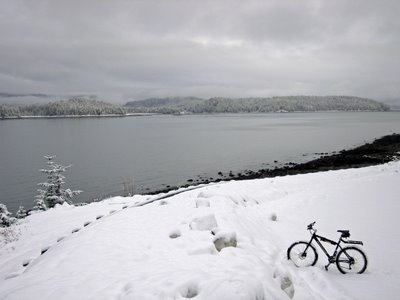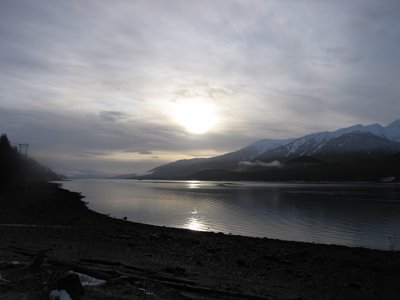 Date: Jan. 24
Date: Jan. 24Mileage: 50.5
January mileage: 652.1
Temperature upon departure: 35
Today I had the perfect shot lined up. A small window of sunlight had broken through the clouds and cast filtered sunlight directly on the Mendenhall Glacier. The result was a blaze of blue so brilliant that it looked like it had been painted on by some overzealous Technicolor artist, flowing indiscriminately from ice to sky. I rode my bike a ways down the trail where bikes weren't allowed, pulled up next to the lake, and unpacked my Camelbak. I removed my camera from its four ziplock bags, pointed the viewfinder at that idealistic Antarctic scene, and click ... nothing. I had left my camera battery at home. I was pretty upset about it. Really. I had a pretty serious sulk going on. I nearly just turned around and went home right there. But then I thought better of it. And I rode for three more hours. And all was right with the world.
Today was a wet day. A wet day. If it were actually scientifically possible to make water any wetter than it already is, that was today. Last year, I dealt more often with very cold temperatures - down to negative-double-digits with wind chills down to negative-kill-me-now. But I have to say, mild cold and wet is a very different problem. A more vexing problem, in many ways. Anyone can eventually figure out how to stay warm in the dry cold - wearing a lot of layers can often be enough. But once you're wet, even 10 layers of polar fleece aren't going to change that fact.
I think I have finally come to a decent solution. It's not about staying dry, because that's impossible. It may be possible for 30 minutes. It may even be possible for an hour, if you have a good rubber suit. But for 4-5 hours, no way. That water is coming in and up and back out from every direction, complete inundation, for hours on end. So, I ask myself, how do people stay warm when they go swimming in cold water? Therein, I'm much closer to a solution.
One of the best things I've done is minimize the layers. The less soggy layers you can get away with, the better. I bought these polar tights from Nashbar, and they're all I wear beneath my 'waterproof' rain pants, which really just serve as wind blockers. For my feet, I finally purchased a good pair of Neoprene socks - NRS Titanium .3mm socks. I wear those with a thin pair of liner socks, a small pair of track running shoes and my Neoprene booties. The double Neoprene layer is toasty. I could swim all day in that. On my torso I only wear a thin liner shirt, one fleece layer and a plastic shell. It's entirely plastic but has vents under the arms, which, of course, just let tons of water in. But it also seems to do a good job of keeping heat it, and blocking wind. Then I wear a thin fleece balaclava ... they're as warm wet as dry, I think. Today, I tried those "handlebar mitt" pogies. I started with thin gloves but had to go down to bare hands because they were so warm. I actually hadn't been able to keep my hands warm in the wet weather yet, even with Neoprene kayak gloves, but the pogies work like a dream. I rode for a little more than four hours today, and they managed to stave off nearly all of the water. The fabric works like tent fabric, I think - it won't leak through until you touch it, and they're so big and loose that they make a little tent over my hands.
In short, after five months, I think I have found my wet weather solution. And it's a little closer to a wetsuit than I'd like to admit.








